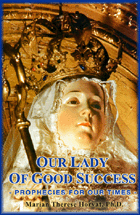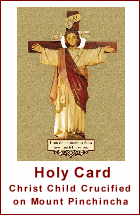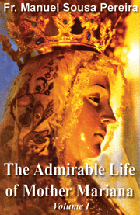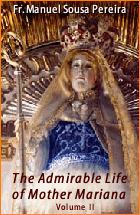NEWS: April 8, 2019
 |
 |
 |
 |
 |
 |
 |
Bird’s Eye View of the News
CONFUSED LANGUAGE, CONFUSED THOUGHTS -
The document issued by the Superior of the Convent of the Immaculate Conception in Quito was not credible, as I showed in my last column because it suffered from some fundamental insufficiencies.
The principal of them is that the Rev. Mother Abbess who signed that document declaring how the Spanish title of Nuestra Señora del Buen Sucesso should correctly be translated into English does not know English, nor do any of the other three signers. Since no one can legislate on a topic he does not know, obviously, the Rev. Mother Abbess is neither qualified nor entitled to decide definitively what is or is not common usage in English.
Today, I will go one step further.
The chief promoter of the new English titles Our Lady of Buen Suceso and Our Lady of the Good Event, as proposed in that document, is Rev. Fr. Adam Purdy, an American SSPX priest.
/bev231_Blind-1.jpg)
/bev231_Blind-2.jpg) If I am to believe what he said in his sermon on February 2, 2019, delivered at the High Mass in the Conceptionist Convent in Quito, Fr. Purdy
If I am to believe what he said in his sermon on February 2, 2019, delivered at the High Mass in the Conceptionist Convent in Quito, Fr. Purdy
So then, we have a decision issued in Spanish by nuns who do not know English on the best and most authentic way a Spanish title should be translated into English; this decision is being spread in English as being the best translation from that Spanish title by a priest who does not know Spanish.
Doesn’t it look like blind men making decisions about color hues?
What value should a serious person give to that decision and this propaganda?
Confused thoughts
Our Lady told Mother Mariana de Jesus Torres in an apparition that she wanted to be called Virgen del Buen Suceso or Maria del Buen Suceso or Nuestra Señora del Buen Suceso. I will leave the precision on the first part of these titles for another time.
When the document signed by the Rev. Mother Abbess tried to explain the Buen Suceso to which Our Lady referred, it affirmed that she was referring to the Presentation of Our Lord in the Temple. The emphasis is placed on Our Lord and not on Our Lady. With this focus as the starting point, the three central paragraphs of the explanation attempt to show that the Purification of Our Lady is subordinate to the Presentation of Our Lord.
I believe that both the emphasis and the term good success (buen suceso) in this document are different from what the Catholic Church habitually teaches.
1. The emphasis: The whole Roman Catholic Church has always considered this Feast of February 2 to be a Marian feast, with the emphasis placed on the Purification of the Virgin Mary and not on the Presentation of Our Lord. Dom Guéranger is quite clear on this regard:
“The Greek Church and the Church of Milan count this feast among those of Our Lord. But the Church of Rome has always considered it as a feast of the Virgin Mary. It is true, it is Our Savior who is this day offered in the Temple, but this offering is the consequence of Our Lady’s Purification. The most ancient of the Western Martyrologies and Calendars call it the Purification. The honor thus paid by the Church to the Mother tends in reality to the greater glory of her Divine Son, for He is the Author and the End of all those prerogatives which we revere and honor in Mary.” (Prosper Guéranger, The Liturgical Year, Fitzwilliam, NH: Loreto Publications, 2000, vol. 3, p. 469)
Dom Guéranger stresses the Church’s long tradition of commemorating the Purification in this way:
“Several learned writers, among whom we may mention Henschenius and Pope Benedict XIV, are of the opinion that this Solemnity was instituted by the Apostles themselves. This much is certain, that it was a long-standing feast even in the fifth century.” (Ibid.)
So, the three principal paragraphs of the document where supposedly the Mother Abbess set forth how we should understand the Presentation in order for us to comprehend the significance of this Feast do not reflect the sentire cum Ecclesia.
2. The buen suceso: To determine what suceso Our Lady was referring to when she spoke to Mother Mariana, I distinguish different perspectives:
A. According to the Jewish Law, every mother who gave birth to a child should stay away from the Temple for a period of 40 days to purify herself from the prosaic conditions of a normal birth under the rule of original sin. After that period, the mother would go to the Temple and end the period of purification by offering either a pair of doves or a lamb, depending on the family’s financial situation. After making that offering the woman was considered pure. As a pure lady, she would present her child to God.
/bev231_Temple.jpg) That purification cannot be understood without parturition; parturition cannot be understood without the birth of a child. Therefore, the suceso upon which the Law was focusing was the birth of the child. This was the buen suceso to be considered, with the necessary consequence of the purification.
That purification cannot be understood without parturition; parturition cannot be understood without the birth of a child. Therefore, the suceso upon which the Law was focusing was the birth of the child. This was the buen suceso to be considered, with the necessary consequence of the purification.
B. We know that Our Lady did not need purification because she was born without original sin and her virginal parturition was spared the normal conditions of other mothers. Consequently, she fulfilled the Law as a manifestation of her humility and obedience. For her, the good success was not to be purified since she was never impure, but the successful birth of her Child.
C. In the Liturgical Year, the Feast of the Purification closes the Christmas season. The good news is still the Birth of Christ, this is the good success. If the Presentation were the good success, as the document pretends, the Feast should start a new cycle instead of ending the Christmas cycle. Since this is not the case, the good success should be considered the Birth of Christ.
D. For centuries pregnant women were inspired by grace to have recourse to Our Lady on this Feast Day of February 2, asking her to give them a happy delivery. The Feast of Candlemas, the Feast of Our Lady of Candelária, the Feast of Our Lady of the Light all represent a single devotion under different invocations asking the Virgin Mary on the same day for the same precise favor: to have a successful parturition. This traditional devotion seems to establish that the good success to which Our Lady referred when giving her title to Mother Mariana was the happy Birth of Our Lord.
/bev231_OLGS.jpg) Based on these facts, I have to say that it is particularly sad to see that, in a Convent of Conceptionist nuns who should be particularly turned toward the contemplation and admiration of the conception and birth of Christ, the Mother Abbess issued a public document affirming to any and all readers that the reason Our Lady chose the title of good success is not based on the Birth of Christ, but on his Presentation.
Based on these facts, I have to say that it is particularly sad to see that, in a Convent of Conceptionist nuns who should be particularly turned toward the contemplation and admiration of the conception and birth of Christ, the Mother Abbess issued a public document affirming to any and all readers that the reason Our Lady chose the title of good success is not based on the Birth of Christ, but on his Presentation.
This seems to me so awkward that I am led to imagine that either the Mother Abbess did not read with close attention the document she signed or she was obliged to issue it under obedience. Someone else would have given to her a document she did not write for her to sign.
Who would be this person? In the absence of material evidence, juridical tradition leads us to ask: Quo bono? Who benefits from that document? I mentioned three persons acting together: the “good” Arch. Travez, who has obliged those nuns to do many other things against their will, the SSPX agent Liboro who is acting inside the Convent, and Fr. Adam Purdy, who is incessantly repeating in the U.S. the same awkward arguments of that document.
The common goals of these three persons were (a) to expel from the Convent the disciples of Prof. Plinio Corrêa de Oliveira who were in charge of moving the Statue of Our Lady of Good Success from the upper choir to the main altar of the Church, and (b) to take over this devotion in the United States.
Continued

The principal of them is that the Rev. Mother Abbess who signed that document declaring how the Spanish title of Nuestra Señora del Buen Sucesso should correctly be translated into English does not know English, nor do any of the other three signers. Since no one can legislate on a topic he does not know, obviously, the Rev. Mother Abbess is neither qualified nor entitled to decide definitively what is or is not common usage in English.
Today, I will go one step further.
The chief promoter of the new English titles Our Lady of Buen Suceso and Our Lady of the Good Event, as proposed in that document, is Rev. Fr. Adam Purdy, an American SSPX priest.
/bev231_Blind-1.jpg)
Nuns who do not know English decide on the best way a Spanish title should be in English...
/bev231_Blind-2.jpg)
... this is presented as the best translation from Spanish by a priest who does not know Spanish
- has been going to Quito for several years on that date;
- is now playing an active role in organizing the Procession of the Dawn (Procesión de la Aurora), which used to be a single procession made in the early morning hours of February 2 and now has been replaced by the SSPX with a series of processions made at dawn on the days preceding that Feast Day, and
- is the SSPX spokesman on this topic. Followers of the SSPX who are now publicly opposing the title Our Lady of Good Success in English always quote him as the final authority on this matter.
So then, we have a decision issued in Spanish by nuns who do not know English on the best and most authentic way a Spanish title should be translated into English; this decision is being spread in English as being the best translation from that Spanish title by a priest who does not know Spanish.
Doesn’t it look like blind men making decisions about color hues?
What value should a serious person give to that decision and this propaganda?
Confused thoughts
Our Lady told Mother Mariana de Jesus Torres in an apparition that she wanted to be called Virgen del Buen Suceso or Maria del Buen Suceso or Nuestra Señora del Buen Suceso. I will leave the precision on the first part of these titles for another time.
When the document signed by the Rev. Mother Abbess tried to explain the Buen Suceso to which Our Lady referred, it affirmed that she was referring to the Presentation of Our Lord in the Temple. The emphasis is placed on Our Lord and not on Our Lady. With this focus as the starting point, the three central paragraphs of the explanation attempt to show that the Purification of Our Lady is subordinate to the Presentation of Our Lord.
I believe that both the emphasis and the term good success (buen suceso) in this document are different from what the Catholic Church habitually teaches.
1. The emphasis: The whole Roman Catholic Church has always considered this Feast of February 2 to be a Marian feast, with the emphasis placed on the Purification of the Virgin Mary and not on the Presentation of Our Lord. Dom Guéranger is quite clear on this regard:
“The Greek Church and the Church of Milan count this feast among those of Our Lord. But the Church of Rome has always considered it as a feast of the Virgin Mary. It is true, it is Our Savior who is this day offered in the Temple, but this offering is the consequence of Our Lady’s Purification. The most ancient of the Western Martyrologies and Calendars call it the Purification. The honor thus paid by the Church to the Mother tends in reality to the greater glory of her Divine Son, for He is the Author and the End of all those prerogatives which we revere and honor in Mary.” (Prosper Guéranger, The Liturgical Year, Fitzwilliam, NH: Loreto Publications, 2000, vol. 3, p. 469)
Dom Guéranger stresses the Church’s long tradition of commemorating the Purification in this way:
“Several learned writers, among whom we may mention Henschenius and Pope Benedict XIV, are of the opinion that this Solemnity was instituted by the Apostles themselves. This much is certain, that it was a long-standing feast even in the fifth century.” (Ibid.)
So, the three principal paragraphs of the document where supposedly the Mother Abbess set forth how we should understand the Presentation in order for us to comprehend the significance of this Feast do not reflect the sentire cum Ecclesia.
2. The buen suceso: To determine what suceso Our Lady was referring to when she spoke to Mother Mariana, I distinguish different perspectives:
A. According to the Jewish Law, every mother who gave birth to a child should stay away from the Temple for a period of 40 days to purify herself from the prosaic conditions of a normal birth under the rule of original sin. After that period, the mother would go to the Temple and end the period of purification by offering either a pair of doves or a lamb, depending on the family’s financial situation. After making that offering the woman was considered pure. As a pure lady, she would present her child to God.
/bev231_Temple.jpg)
Mary and Joseph at the Temple:
first the Purification, then the Presentation
B. We know that Our Lady did not need purification because she was born without original sin and her virginal parturition was spared the normal conditions of other mothers. Consequently, she fulfilled the Law as a manifestation of her humility and obedience. For her, the good success was not to be purified since she was never impure, but the successful birth of her Child.
C. In the Liturgical Year, the Feast of the Purification closes the Christmas season. The good news is still the Birth of Christ, this is the good success. If the Presentation were the good success, as the document pretends, the Feast should start a new cycle instead of ending the Christmas cycle. Since this is not the case, the good success should be considered the Birth of Christ.
D. For centuries pregnant women were inspired by grace to have recourse to Our Lady on this Feast Day of February 2, asking her to give them a happy delivery. The Feast of Candlemas, the Feast of Our Lady of Candelária, the Feast of Our Lady of the Light all represent a single devotion under different invocations asking the Virgin Mary on the same day for the same precise favor: to have a successful parturition. This traditional devotion seems to establish that the good success to which Our Lady referred when giving her title to Mother Mariana was the happy Birth of Our Lord.
/bev231_OLGS.jpg)
The good success of Our Lady
was the Birth of Our Lord
This seems to me so awkward that I am led to imagine that either the Mother Abbess did not read with close attention the document she signed or she was obliged to issue it under obedience. Someone else would have given to her a document she did not write for her to sign.
Who would be this person? In the absence of material evidence, juridical tradition leads us to ask: Quo bono? Who benefits from that document? I mentioned three persons acting together: the “good” Arch. Travez, who has obliged those nuns to do many other things against their will, the SSPX agent Liboro who is acting inside the Convent, and Fr. Adam Purdy, who is incessantly repeating in the U.S. the same awkward arguments of that document.
The common goals of these three persons were (a) to expel from the Convent the disciples of Prof. Plinio Corrêa de Oliveira who were in charge of moving the Statue of Our Lady of Good Success from the upper choir to the main altar of the Church, and (b) to take over this devotion in the United States.
Continued

/bev231_Doc.png)









